The power of the sea draws many of us to it, fascinated by the continual ebb and flow, the never-resting vitality of the waves, the life beneath the surface and on the shore, with many of us – besides those making their living from the sea – associating the beach with rest and recreation and taking time out from our usual routines.
The seaside can remind us of nature at its most elemental – thundering surf on sand and rock, powerful winds and deep currents that can overwhelm us. Away from the coastal cities and beach resorts the seashore can seem timeless and unspoiled.
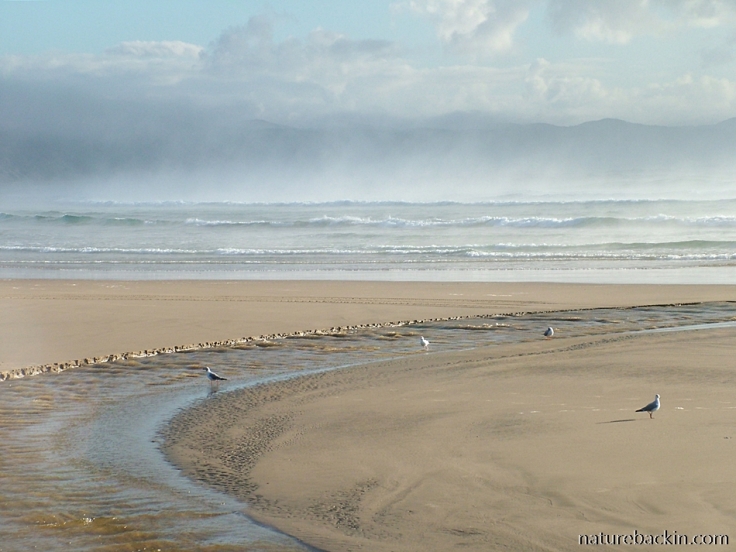
After dawn at Sodwana Bay with high dunes just visible through the rising mists
Sodwana Bay, on the northern KwaZulu-Natal coast in Maputaland might seem to be such a place – somehow timeless, primordial even. But the bay is part of a dynamic system – even the lagoon (that can be seen flowing into the sea in the photo above) is constantly changing its course in response to events inland that effect the flow of water, and events in the ocean that change the shape of the beach.

The curve of the high dunes that form a crescent around the bay at Sodwana, with a foreground of glistening sand as the tide goes out
The Maputaland coast is relatively undeveloped for tourism. Much of it forms part of iSimangaliso Wetland Park and the adjacent Maputaland Marine Reserve, which is well known for providing a protected nesting area for sea turtles. Leatherback and Loggerhead turtles regularly visit to make nests where they lay their eggs above the high-tide line, and more rarely Greenback turtles are on record for nesting there too.

Nesting turtles and other forms of wildlife in the littoral zone have been impacted – sometimes quite literally by crushing – by beach driving, resulting in vehicles being banned from driving on the beaches on substantial stretches of the Maputaland shoreline
Sodwana Bay is a mecca for scuba divers – the offshore reefs and canyons provide habitats for an incredible variety of marine life. Sodwana Bay is recognised as being one of the world’s top scuba diving sites. The first time I went there was in fact to scuba dive, having just completed several weeks of theory and swimming-pool training. The calm warm waters and a choice of relatively shallow dive sites make it a brilliant place for newly-qualified divers to learn how to dive in open water.
And so we arrived full of anticipation at Sodwana Bay with our dive instructor and a small group of other divers, but I was unprepared for what I found on the part of the bay designated for dive operators.

High density hustle and bustle from the dive operators on the southern section of the beach at Sodwana Bay

Heavy vehicles for towing boats and tractors for pushing dive boats in and out of the water line up on the sands

The above photo does not avoid showing the hectic tyre tracks on the beach and around the lagoon. This photo was taken at a period when the lagoon was not flowing into the sea

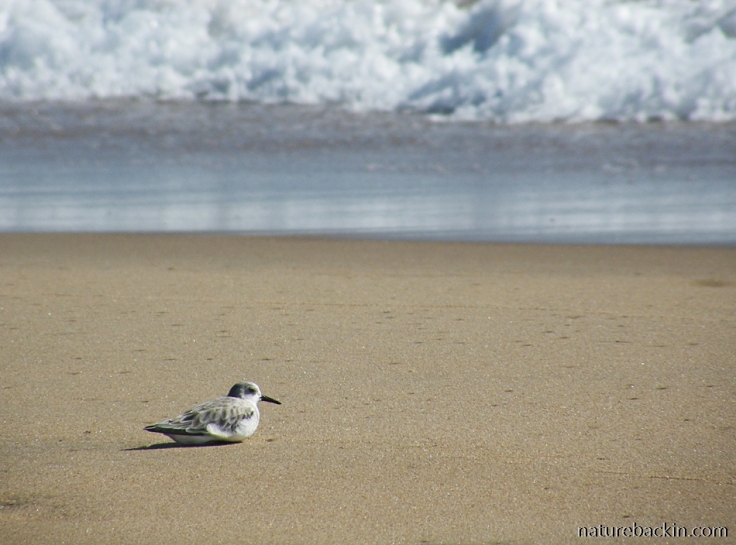
A Sanderling enjoying a quiet moment in the morning sun before most of the traffic arrives on the beach. In South Africa, Sanderlings are non-breeding migrants from Siberia or Greenland

Filled with expectation for the dive, a group of divers push and pull the dive boat out into the surf

The skipper waits for a gap in the waves so he can take his group of divers out to the dive site

Off they go, this time in an unusually choppy sea
Apart from the thrill of being out in open water, there is much for divers to see offshore. Being more used to snorkelling or seeing brightly lit underwater photographs, I was surprised at how quickly the colour disappears as one descends underwater. Although I had been told about it, it is quite another thing to experience the colours literally being greyed out. Water, being denser than air, absorbs light – so much so that red disappears at a depth of around 5 metres, to be followed by the disappearance of orange at about 10 metres and yellow at around 20 metres.

The typical bluey-grey light and colour at a depth of about 18 metres evident in this photo of coral and attendant fish on a shallow reef not far from Sodwana Bay. This photo was taken by my husband
So, apart from being surprised by the loss of colour, how was my first dive? Well to start off with, my husband and I were taken by surprise at the buoyancy in the salty water and so we were slow to descend and got separated from the group. Alarmingly, we found ourselves all alone in the great blue. We surfaced and could see only swelling waves – no boat, no land, only waves. Anyway, eventually we got our bearings from the anxious shouting of our instructor who had come to surface and was not far away.
Reunited with the group and 17 metres down, I started to relax and let the gentle surge wash me to and fro. Everything – the seaweed, the fish, the bubbles – was gently washing to and fro, to and fro. Unfortunately, I am very prone to motion sickness and soon found myself vomiting heartily under the sea. I removed the breathing mouthpiece when necessary and took careful breaths in between releasing my breakfast into the ocean. Once that was all over, my instructor asked me to clear my mask – a strange request under the circumstances, I thought. Turned out, painlessly and unknown to me, something in my nasal passages had popped and my mask was filling with what he later described as “blood and gunk”.
Anyway, I finished the dive, but back on the boat the smell of petrol exhaust from the motors triggered another bout of me being sick – not something the other divers sitting in my line of fire while they were holding on for dear life on the bumpy ride back home particularly appreciated. The aftermath of my dive was a nasty ear infection, and so since then I have decided to limit myself to paddling or snorkeling when at the seaside.

A Honeycomb Moray Eel photographed by my husband – something my non-diving self has not seen
Meanwhile back on the shore not everyone is involved with diving. People visit for many reasons, including coming to swim or to play beach games, to fish or to explore the rock pools or take a quiet walk along the shoreline.

Enjoying the warm surf

On a day when high seas made launching boats and diving impossible, this fisherman nevertheless decided to try his luck
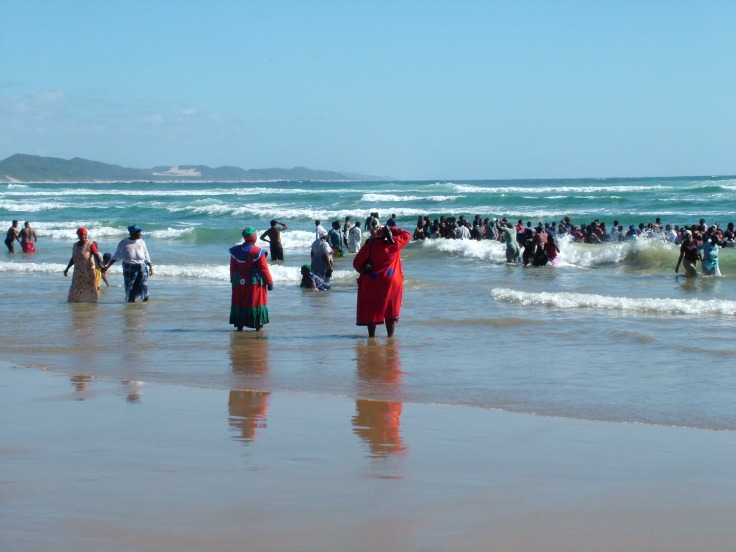
A church group entering the sea for ritual purposes

Children enjoying the sheltered waters of the lagoon

It is advisable not to venture too far upstream
The reason why in this post I ventured out from suburbia and started thinking about the seaside is in response to the announcement this week of the approval of the IPCC Special Report on the Ocean and Cryosphere in a Changing Climate from the Intergovernmental Panel on Climate Change. For an in-depth summary of the report see https://www.carbonbrief.org/in-depth-qa-the-ipccs-special-report-on-the-ocean-and-cryosphere. The IPCC press release emphasises that choices made now are critical for our oceans and the frozen components and regions of the Earth. I urge you to read these or other summaries of this important report – how our governments and corporations respond or fail to respond has far reaching consequences for all of us.
As the IPCC notes in its press release: Global warming has already reached 1°C above the pre-industrial level, due to past and current greenhouse gas emissions. There is overwhelming evidence that this is resulting in profound consequences for ecosystems and people. The ocean is warmer, more acidic and less productive. Melting glaciers and ice sheets are causing sea level rise, and coastal extreme events are becoming more severe.
The report provides “new evidence for the benefits of limiting global warming to the lowest possible level – in line with the goal that governments set themselves in the 2015 Paris Agreement. Urgently reducing greenhouse gas emissions limits the scale of ocean and cryosphere changes. Ecosystems and the livelihoods that depend on them can be preserved”.



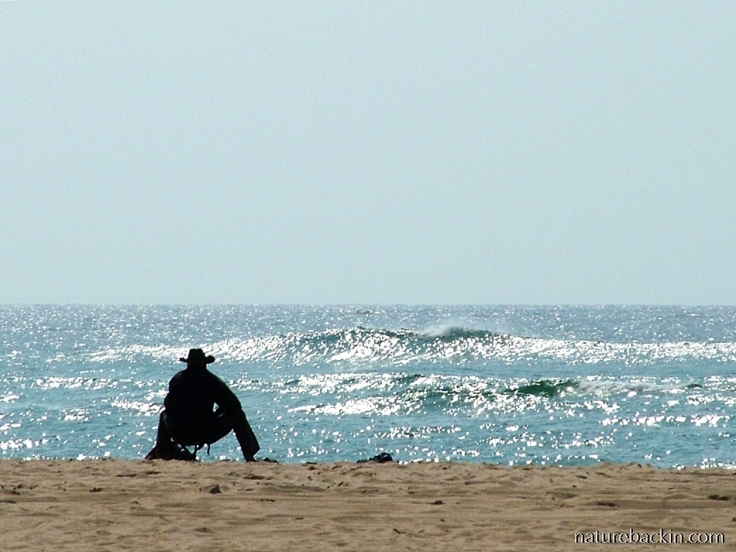
Posted by Carol

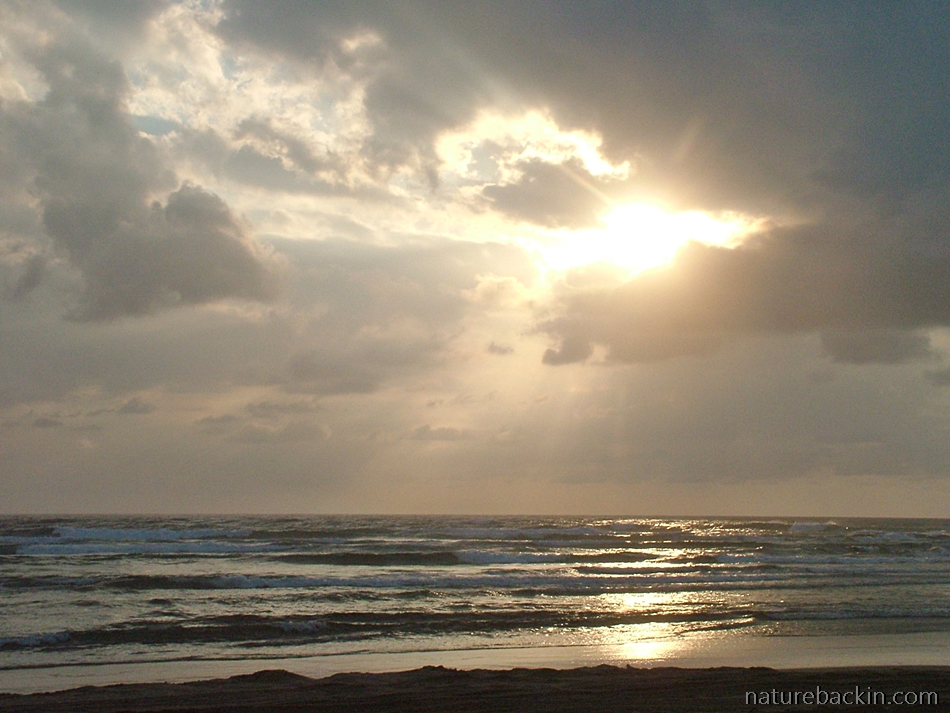







October 2, 2019 at 9:06 am
Thanks Carol, we were on our first visit to Maputoland coast ( St Lucia, Cape Vidal, Sodwana Bay and Kosi Bay) in August so your pictures of and comments on Sodwana Bay came fresh to my mind. For us, from the Cape, where the ocean is much colder, it was great to swim in the warm water and stay in for hours! Not possible here, although I still snorkel in Onrus Harder Bay in summer and get inspiration for paintings from the beautiful colours in shallower waters!
LikeLiked by 1 person
October 3, 2019 at 4:18 pm
I am glad you enjoyed your trip to warmer waters, Suzette 🙂 I am in awe that you snorkel in your chilly waters, but the pay off for your paintings makes it even more worthwhile.
LikeLike
September 30, 2019 at 9:02 pm
Hi Carol, What a powerful post, thank you. (we are on the same wavelength about climate change this week) Your photos are terrific and I was very nervous when you got separated from your dive group! Appreciate the link to the report and your passion for natural environment.
LikeLiked by 1 person
October 3, 2019 at 4:14 pm
Thank you Jane for your generous comment. And yes I also thought that we were on the same wavelength this week, and hopefully along with very many others too!
LikeLiked by 1 person
September 29, 2019 at 4:19 pm
I was enjoying this very different post till I discovered how badly you had been affected – so sorry. But lovely photos as usual. The lack of real action from governments and the wider business community, and the level of abuse directed at those working for climate change is quite frightening, isn’t it?
LikeLiked by 1 person
September 29, 2019 at 8:24 pm
Thanks Margaret. That dive was some time back and I am quite content to stay more within my element 🙂
I agree that the level of abuse is frightening, How incredible to troll and trash those who simply say learn about the science and take real action now? How incredible that vested interests go to such lengths to deny the undeniable at such a terrible cost?
And to digress, I am really sad at the frightening goings on too in your parliament. What a nightmare.
LikeLike
September 29, 2019 at 9:10 pm
Nightmare indeed. I keep hoping to wake up.
LikeLike
September 29, 2019 at 9:13 pm
What to say?
LikeLiked by 1 person
September 29, 2019 at 4:17 pm
Good on you for coming back from such an horrendous ordeal with such beautiful images, Carol!
Throngs of people and vehicles on the beach, getting lost at sea, getting sick at sea, loosing “blood and gunk” at sea – I could already hear the theme music to “Jaws” as I read with relief that you’ve decided not to go scuba-diving again. Phew.
I am a true “Vaalie” – my policy is that if my swimming trunks are wet I have gone in far enough…
LikeLiked by 1 person
September 29, 2019 at 8:16 pm
Your description is an excellent and amusing summation 🙂 However, my husband continued diving and really enjoyed it for some years after that – I have been quite happy to make like a “Vaalie” and potter around on the beach and in the shallows 🙂
LikeLiked by 1 person
September 29, 2019 at 10:04 am
Another remarkable and hard hitting post, Carol. Thank you for rich information, beautiful photographs and for making us more aware of both the beauty and importance of the ocean and climate change.
Glad to know you survived that dive.
LikeLiked by 1 person
September 29, 2019 at 8:12 pm
Thanks Mariss.
Yup that dive was sometime back, but well remembered 🙂
LikeLiked by 1 person
September 29, 2019 at 6:19 am
Dear Aunty Carol
What an adventure, never mind I would have been right there next to you loosing my breakfast too 😂.
Thank you for a very informative article. Climate change for me is terrifying, I wish we could all just do our bit and make a difference.
All my love Deb
LikeLiked by 2 people
September 29, 2019 at 8:11 pm
Thanks Debs – ja but I can recall you surviving a somewhat hectic spinning fairground ride!
I am also overwhelmed by climate change and that it is evermore evident in our daily lives – but we have to carry on doing what we can to try to make a difference.
Love to you all ♥
LikeLike
September 28, 2019 at 6:22 pm
Interesting post – it hadn’t occurred to me that diving might trigger motion sickness but having had dreadful sea sickness while still in a boat, I can sympathise!
That eel has extraordinary markings, somewhere between a leopard and paned glass.
LikeLiked by 1 person
September 29, 2019 at 8:06 pm
Thanks Adele. I think that it was not the diving per se that triggered the motion sickness but the constant swinging back and forth, to and fro of the gentle surge. Had I been diving in a train-like current I probably would have been fine! Too bad you have also experienced sea sickness.
I like your description of the eel’s distinctive markings.
LikeLiked by 1 person
September 28, 2019 at 11:19 am
Always so much information within your posts, Carol; I had no idea about colours as one descends. Your diving experience sounds challenging to say the least! The coastal and underwater shots are beautiful as always – and a reminder of the precipice we stand on.
LikeLiked by 1 person
September 29, 2019 at 8:02 pm
Thanks Sandra. I was also interesting in the loss of colour underwater. Indeed, we do stand on a precipice.
LikeLiked by 1 person
September 28, 2019 at 6:22 am
Sorry to hear you got so sick on your diving trip. It’s not something I’ve had an issue with, but I’ve seen it ruin other people’s time on or in the water. I’ve never tried diving and probably won’t now. The thing for me is, when I go for a snorkel, I see divers checking their gear and their wetsuits and their tanks, and when I get back from my swim, many times they still haven’t got in. I don’t think I could do that on a regular basis. Granted they see things I won’t, but I see an awful lot near the surface and, like you said, the colors are great.
Frankly, the best way to get the powers that be to do something about ocean warming is to figure out how they can make money doing that. Then they’ll be on board in a hurry. My one consolation is that all the wealthy naysayers with homes on the water are going to be among the first to be affected by climate change. No doubt they’ll then start lambasting the government and demand compensation. Aaaaargh!
I do like how your post talks about the changes on the beach. Having lived near the ocean most of my life, I’ve always enjoyed how sands shift and water channels come and go.
LikeLiked by 1 person
September 29, 2019 at 7:57 pm
Yes, it is interesting how dynamic beaches are, even those hemmed in by concrete developments.
I agree about the money people. Yet it can be perplexing that those with power and money are happy to subsidize fossil fuel industries, for example, but I guess if one follows the money the reasons might be clearer …
I agree about snorkeling being so much simpler, quicker and independent than scuba diving – and one gets to see the vivid colour. Motion sickness can seem to be a weird thing, but then I have also had the craziest virtual fairground-adventure-rides courtesy of middle ear infections all in the safety of my own home 🙂
LikeLiked by 1 person
October 1, 2019 at 5:17 am
There was a great story about a beach in Ireland that disappeared during a storm and then reappeared 33 years later (https://www.theguardian.com/world/2017/may/08/irish-beach-washed-away-reappears-freak-tide).
Glad to hear you’ve made the best of middle ear infections. I’m happy to take your word on that one!
LikeLiked by 1 person
October 3, 2019 at 4:15 pm
Thanks for the link re the reappearing beach. Most intriguing!
LikeLiked by 1 person
September 27, 2019 at 8:43 pm
Beautiful images and interesting thoughts as usual. We should all be mobilising now – it is late.
LikeLiked by 1 person
September 29, 2019 at 7:45 pm
Thank you Leya. Yes we all should be mobilising and learning – the one informing the other.
LikeLike
September 30, 2019 at 7:18 am
💚
LikeLiked by 1 person
September 27, 2019 at 4:29 pm
I’m sorry you can’t stand diving. For me this is also not possible for similar reasons. But snorkeling is also a nice thing. Sometimes you just have to accept that.
This is a nice Lagoon and I hope for the locals they can enjoy the area in future. Sea level rise can have dramatic consequences.
LikeLiked by 1 person
September 27, 2019 at 7:17 pm
I am okay with not diving – for one thing it is potentially dangerous. At least with snorkeling one is more in control and also the light is good so all the creatures one sees retain their colours.
Yes, I hope this coastal region is not subjected to any major storms as the weather patterns shift and change
LikeLike
September 27, 2019 at 8:19 am
Wow what an adventure and beautiful presentation. Too good.
LikeLiked by 1 person
September 27, 2019 at 7:13 pm
Thank you Kamal.
LikeLike
September 28, 2019 at 4:06 am
Welcome 😊😊 😊
LikeLiked by 1 person
September 27, 2019 at 7:26 am
Very many years ago I visited Sodwahana and witnessed the very sad scene of a of ‘new’ boat owners experience. I wonder if its in an old computer file. i will look for it.
LikeLiked by 1 person
September 29, 2019 at 9:16 pm
Just messing about in boats can turn out to be messy …
LikeLike
September 27, 2019 at 5:00 am
Ahhh… the sea and the waves. It won’t come as any surprise to you that I love it and am drawn to it. We are supremely lucky to be living along a beautiful coast where tourism and crowds haven’t affected us as much as those living where the urban areas have easier access. Though there is a noticeable influx in summer.
No crocodiles or turtles here and no diving either. The main sporting activities are kite surfing, wind sailing and plain surfboarding (all requiring wet suits because of our normally cold water). Our beaches are mostly protected from motor vehicles (though there are some restricted exceptions) and there are certain sections completely closed off to the public during the nesting season for snowy plovers.
We do have quite a bit of fishing, both private and commercial. But this year was a very bad year for some of our favorites: crab and salmon (and likely others as well). Climate change is a distinct factor in warmer water that’s bad for most fish. The crab have started producing a toxin due to changing conditions out at sea. None of it is good news for the planet.
Watching Greta Thunberg speaking at the UN and to our politicians has been inspiring. We have started attending local events in support of the changes that desperately need to be made. We can only hope!
Thank you for the issues you raise so well!
LikeLiked by 2 people
September 27, 2019 at 7:12 pm
Thanks Gunta and for the interesting information about your beaches. Good to know that the plovers breeding sites are protected in the nesting season.
Yes Greta Thunberg made a powerful and compelling speech. Hopefully at least some of those in positions of power will start educating themselves and understand the urgency and the need to take decisive steps to mitigate against climate change. It is good that more and more citizens of the world are mobilising.
LikeLiked by 1 person
September 27, 2019 at 8:43 pm
We can only hope and work at convincing those positions of power!
LikeLiked by 1 person
September 27, 2019 at 4:35 am
In an interesting coincidence, I recently visited the aquarium at the Waterfront in Cape Town and was fascinated all over again by the variety of life under the sea. They are doing a wonderful job there of educating the public by subtle – and not so subtle – means about the importance of the oceans, plastic pollution and making correct environmental choices. I was struck by the awe on the faces of many visitors looking through the displays for the average holidaymaker has little idea of what lies under the waves. You have provided a fine example in a different sense.
LikeLiked by 1 person
September 27, 2019 at 7:07 pm
Thank you Anne. It is good to know that Two Oceans is doing a good job and that people are responsive to the wonders of the undersea world.
LikeLike
September 26, 2019 at 10:32 pm
I love a day at the ocean, but am not sure I’d brave diving within like you did. The surf was definitely rough that day, no wonder you were ill.
My sincere hope is that the powers that be will listen to this latest IPCC report. We are already at the tipping point (if not beyond), and the amount of $ needed to correct far outweighs the cost that will arise out of ‘acts of God’ as Nature takes its course.
LikeLiked by 1 person
September 27, 2019 at 7:04 pm
I also hope that those with power take notice of the latest IPCC report, but there isn’t much to indicate that most will. Seems making a fast buck is more important than anything else, and perhaps they think that longer term financial costs will not be for their account and that they can protect themselves even as ecosystems break down and sea levels rise. Too bad about the planet and the rest of us.
LikeLiked by 1 person
September 27, 2019 at 7:08 pm
That disconnect will be their downfall, and sadly, ours as well.
LikeLiked by 1 person
September 26, 2019 at 10:25 pm
I love how you showed so many different aspects and angles of the shore. Your images are beautiful and thought-provoking. The image of the lone sanderling is also striking. As always, thank you for sharing 🙂
Best wishes,
Takami
LikeLiked by 1 person
September 27, 2019 at 6:58 pm
Thanks very much Takami. I thought there was something about the sanderling that was rather poignant under the circumstances. Best wishes to you too.
LikeLiked by 1 person
September 26, 2019 at 9:12 pm
What an adventure! Love all the blue fish 🙂
LikeLiked by 1 person
September 27, 2019 at 6:56 pm
Thanks. I had not really thought of it as an adventure, but I suppose it was! 🙂
LikeLiked by 1 person